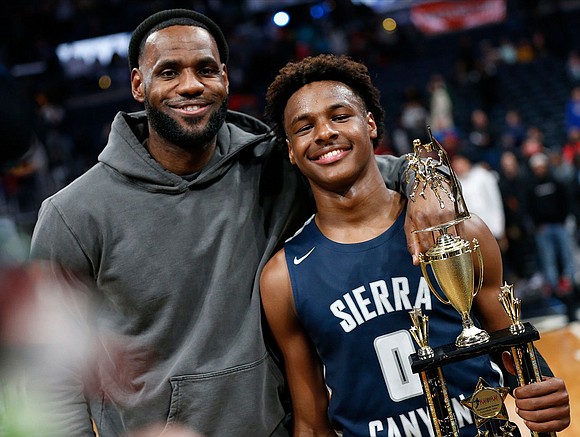‘Get an ambulance here now’: 911 call reveals response to Bronny James’ cardiac arrest
CNN/Stylemagazine.com Newswire | 7/28/2023, 2:30 p.m.

Originally Published: 27 JUL 23 12:26 ET
Updated: 28 JUL 23 09:09 ET
By Jacob Lev, Paul P. Murphy and Holly Yan, CNN
(CNN) — The frantic call underscored the dire emergency:
“Listen … listen to me,” a distraught man tells a 911 operator. “Get an ambulance here now.”
“All right, sir, we’re going to send help,” the operator responded. “Don’t hang up, sir, don’t hang up.”
Bronny James, the 18-year-old son of NBA legend LeBron James, had gone into cardiac arrest during basketball practice. The incoming freshman for the University of Southern California’s basketball team was hospitalized Monday, his family had said.
He has since been released from Cedars-Sinai Medical, the Los Angeles hospital said Thursday.
“Although his work-up will be ongoing, we are hopeful for his continued progress and are encouraged by his response, resilience, and his family and community support,” said Dr. Merije Chukumerije, a cardiologist at Cedars-Sinai.
Chukumerije complimented the “swift and effective response” of the USC athletics medical staff.
“He arrived at Cedars-Sinai Medical Center fully conscious, neurologically intact and stable,” Chukumerije said Thursday.
CNN obtained the 911 call after a public records request, and the Los Angeles Fire Department redacted a significant portion of the call, they said, in accordance with California public records disclosure laws.
The operator asks if there is “a doctor on scene” or a registered nurse and the caller says a doctor is not there.
CNN has not been able to independently verify if there was medical staff on scene outside the caller’s view.
Typically, an athletic trainer would be present at a collegiate practice. According to the NCAA, “All athletic trainers, team physicians and strength and conditioning coaches have received training/ certification in CPR and automated external defibrillator (AED) use.”
On Thursday, LeBron James tweeted about his son for the first time since the practice incident, thanking well-wishers for sending his family “love and prayers.”
“We feel you and I’m so grateful. Everyone doing great,” the Lakers star wrote. “We have our family together, safe and healthy, and we feel your love. Will have more to say when we’re ready but I wanted to tell everyone how much your support has meant to all of us! #JamesGang”
Cardiac arrest occurs when electrical disturbances cause the heart to suddenly stop beating. It may be fatal if not immediately treated but can be reversed by CPR and a defibrillator, according to the American Heart Association.
The fact Bronny James was released so soon was a very favorable development, CNN Chief Medical Correspondent Dr. Sanjay Gupta said Thursday.
“He’s probably wearing a monitor to monitor his heart rhythms while he’s at home to see if there’s any abnormalities,” Gupta said. “But so far it sounds like there’s nothing serious that they have found and they feel comfortable releasing him.”
Sudden cardiac arrest among young athletes is rare but not unheard of. A 2011 study examining NCAA student-athlete sudden deaths between 2004 and 2008 found cardiovascular-related sudden death was the leading cause of death in 45 cases, or about 9 each year.
However, Dr. Jonathan Drezner, who specializes in sports cardiology at the University of Washington Medical Center, told CNN James “represents the single highest athlete risk group” for sudden cardiac arrest. Drezner’s research shows Black male NCAA athletes who play Division I basketball have a 1 in 2,000 chance of experiencing sudden cardiac arrest each year. The risk in a White male Division I basketball player is 1 in 5,000, according to his research.
“Adolescent male basketball players and college male basketball players, for reasons that we don’t fully understand, are by far our single highest risk group of athletes for sudden cardiac arrest,” Drezner said. “In my opinion, they should all be screened with more robust and intensive cardiac screening than occurs typically.”
Bronny James had a cardiac screening several months ago as part of a program for prospective NBA players, according to a source familiar with the matter. The screening included a transthoracic echocardiogram, which looks at blood flow through the heart and heart valves, and an EKG, which is a recording of the heart’s electrical activity, the source said. Both screenings came back with normal results.
The 6-foot-3 combo guard graduated this spring from Sierra Canyon High School in Los Angeles, where he averaged 14.1 points, 5.6 rebounds, 2.4 assists and 1.7 steals his senior year. He was rated a four-star recruit, and he stood out in the McDonald’s All-American Game in March, featuring some of the country’s top high school basketball players.
Experts say it’s hard to map out exactly what James’ recovery will look like until more is known about the cause of his cardiac arrest and his specific health condition. But the fact he was treated immediately and is already out of the intensive care unit bodes well for his recovery, Drezner said.








